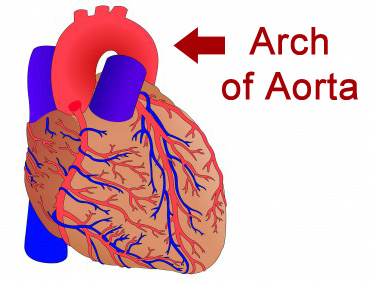Aortic Aneurysms
 An Aortic Aneurysm refers to abnormal enlargement or bulging of the aorta, which is the largest blood vessel in the body. The aorta is the main artery in the human body beginning at the left ventricle of the heart and extending down to the abdomen. The job of the aorta is to transport oxygenated blood from the heart to the rest of the body via the circulatory system. Nearly every artery in the body branches off of the aorta, feeding oxygenated blood to the brain, liver, small and large bowel, spinal cord, nerves, bones, muscles, cells, and more. Aortic Aneurysms have a variety of causes ranging from birth defects to injuries.
An Aortic Aneurysm refers to abnormal enlargement or bulging of the aorta, which is the largest blood vessel in the body. The aorta is the main artery in the human body beginning at the left ventricle of the heart and extending down to the abdomen. The job of the aorta is to transport oxygenated blood from the heart to the rest of the body via the circulatory system. Nearly every artery in the body branches off of the aorta, feeding oxygenated blood to the brain, liver, small and large bowel, spinal cord, nerves, bones, muscles, cells, and more. Aortic Aneurysms have a variety of causes ranging from birth defects to injuries.
There are five segments of the aorta:
- Ascending Aorta - The section between the heart and the arch of the aorta.
- Arch of Aorta - The section that is the peak of the aorta that looks like an inverted "U".
- Descending Aorta - The section which descends from the arch of the aorta which leads to the abdomen.
- Thoracic Aorta - The half of the descending aorta above the diaphragm.
- Abdominal Aorta - The half of the descending aorta below the diaphragm.
The aortic wall is made up of three layers:
- The Endothelium - a layer of smooth cells.
- The Muscular middle - a layer of elastic fibers.
- The Tough Outer Layer.
- A true aneurysm is contained in all three layers of the aortic wall.
- A pseudoneurysm occurs when only the tough outer layer of the aortic wall remains.
Aneurysms occur when a section of the aorta becomes weakened and a bulge is created due to the pressure from the blood flow. Over time the bulge will continue to grow and eventually may rupture causing internal bleeding. An aortic aneurysm can occur nearly anywhere along the aorta but is most common in the abdominal aorta.
There are several different types of aortic aneurysms which are classified by their cause, their shape, and their location in the aorta.
Different types of Aortic Aneurysms include:
- Abdominal Aortic Aneurysms
- Thoracic Aortic Aneurysms
- Dissecting Aneurysms
- Fusiform Aneurysms
- Saccular Aneurysms
Aneurysms can develop slowly and sometimes have no noticeable symptoms at first. When an aneurysm expands quickly or ruptures, symptoms may quickly become evident.
Symptoms include:
- Nausea
- Vomiting
- Clammy skin
- Increased heart rate
- Severe, sudden, persistent, or constant pain in the abdomen
Diagnosis of an aneurysm includes a physical examination, x-rays, ultrasounds, CT scans, and other medical imaging. Treatment options include surgery and placement of a graft via a catheter inserted through a peripheral artery. The risk of a rupture is of paramount concern. A rupture can lead to massive internal hemorrhage and without prompt treatment, death can occur rapidly. Treatment is highly successful when done in a timely manner. Delays in treatment or misdiagnosis of an aortic aneurysm may lead to death.
If you or a loved one has suffered from an aortic aneurysm that led to a rupture or even death, you may find yourself wondering if it could have been prevented. You may begin to question why and how it could have happened.
- Am I a victim of aortic aneurysm misdiagnosis at the hands of my doctor or hospital?
- Did the medical experts and doctors misread my test results?
- Were my symptoms ignored or belittled by a medical professional?
- Could this have been prevented if my doctor acted more quickly?
If you are concerned that you or a loved one may have avoided serious injuries or even death due to mistreatment at the hands of medical professionals, you should contact the Sweeney Law Firm. The Sweeney Law Firm works with medical specialists to examine medical information and determine if a medical malpractice case is justified. If there is evidence of an aortic aneurysm medical malpractice case, the Sweeney Law Firm may be able to recover money damages to cover medical expenses, rehabilitation, lost income, and other expenses, as well as compensation to your family for emotional and physical pain and suffering.
The Sweeney Law Firm reviews possible aortic aneurysm medical malpractice cases at no charge and works on a contingency fee basis. There is no cost for representation unless there is a cash recovery for you.
Image Credit: Copyright (c) 123RF Stock Photos